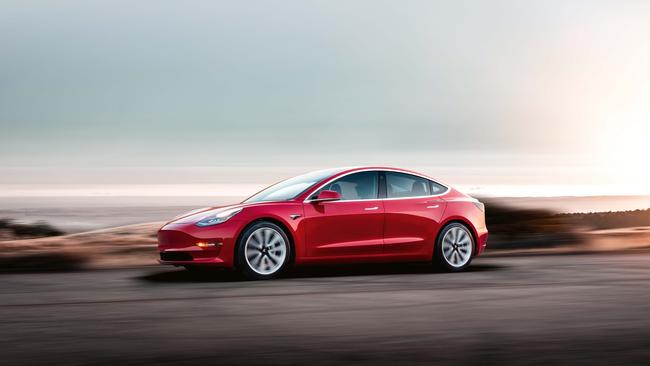Tesla Model 3 Performance AWD: Power move
Once you get used to the way electric motors deliver, they’re addictive. The Model 3 is a triumph.

I’ve just averted a personal climate crisis and, while minuscule on a planetary scale, an electric car was the answer. To be precise, a Tesla Model 3.
It was sitting outside getting broiled by the sun so I opened the special Tesla app on my phone, which allowed me to check the cabin temperature, among other things. Fifty-eight degrees! Happily, Tesla had a solution. The aircon can be started remotely by the app, so I dialled in 21°C and prepared for a long wait – but in less than 10 minutes the cabin was glacial. It wasn’t only quick; it also seemed to have negligible impact on the battery. This reinforced some positive first impressions of a car that comes with a huge back-story.
The Model 3 is Tesla’s first “mainstream car” – the one that makes electric vehicles viable for the average motorist and moves Tesla into the big league of volume manufacturers. The scare quotes are there for a reason, because even the most accessible version starts at $68k (plus on-road costs), twice what most people spend. That’s more than an entry-level BMW 3 Series or Mercedes C-Class. The Model 3, like other Teslas, is a premium car.
For a while it looked as though Tesla had completely stuffed up the manufacturing. Early examples were so bad, special rectification teams were needed to fix them after they came off the California assembly line. As Tesla struggled to achieve its 5000 a week production target, it haemorrhaged cash. Survival hung in the balance.
Now, 18 months later, the picture is very different. Tesla’s shares are soaring, a Chinese factory has come on stream in record time, it’s building another plant near Berlin and about to launch Model Y, a mid-size SUV that founder Elon Musk believes will outsell all its previous cars put together.
The eventual triumph of Model 3 is the reason. In 2019, with output at full speed, Tesla delivered about 300,000 of them. That makes it easily the most popular electric car on the planet. In Australia they began arriving last August and there are already thousands on our roads. They’re easy to spot, with a distinctive cabin arc and full-length glass roof. There’s a mask-like face sans grille, and unadorned surfaces. Tesla hired proper car designers, and it shows.
Inside, the cabin is defined by a bold horizontal wood-faced dash incorporating vents. It’s remarkable for an almost complete absence of controls – there are wands, thumb-rollers on the wheel-spokes and armrest buttons for windows and doors. Everything is controlled via a large pad-style screen. Materials are soft and mainly vegan-friendly.
However, it is clean almost to the point of sterility and there’s zero scope to embellish or customise. It’s as sexy as an airport Hilton. I had concerns that the wide windscreen pillars would obstruct vision and the panoramic roof would offer inadequate protection from the sun but in practice, neither proved a big issue. Rear foot-space is tight, but in other respects it’s roomy enough, and a small “frunk” under the bonnet combines with a large boot for a generous 542 litres of luggage space.
Moreover, the logic of the control screen plus its speed of operation are exemplary. After five minutes in most cars I’m cursing the software. Not here, although I would swap some screen size for a head-up display, so that speed and other info is line-of-sight. And the screen is so large, some of it is hard to reach. Appropriately, for a Silicon Valley product, software is where you’ll find the car’s quirks – games, Netflix, and little examples of Musk’s sense of humour. Stuff to keep you amused during recharging.
The test car, the top grade of three, brings the most powerful twin-motor combination of 353kW/639Nm and all-wheel drive. Acceleration is very rapid – 3.4s to 100km/h. It squats a little on its rear wheels, making the steering light, but it’s otherwise smooth and fuss-free. It can overtake with complete authority and dart into gaps. Once you get used to the way electric motors deliver, they’re addictive.
The absence of engine noise makes other sounds – wind, creaks, tyre roar – more obvious. There’s a disconcerting lack of confirmation about switching on and off. But you get used to these traits.
Model 3 impresses dynamically, too. The chassis has credentials to suggest driver priorities and, some ride lumpiness aside, it points and goes in an engaging manner. Once you’ve allowed for an absence of gears, steering feel and the sound of an engine finding its rev limits, that is. Certainly, I wouldn’t tire of its instant throttle response or general good manners.
And with this car, as with other new electric cars, range anxiety is receding. Fully charged, it has a 530km range on European tests and while that’s optimistic, a real-world figure of about 450km would be enough for most. Particularly as a 20-minute recharge tops up with impressive speed, adding about 180km.
After a difficult birth, Model 3 has hit its stride and it’s a convincing, if pricey, result. Model 3 will be the first Tesla to face serious competition from traditional car-makers, with strong alternatives now available from other brands. But Tesla is the one winning over the sceptics.
Tesla Model 3 Performance AWD
Engine: Electric motors (353kW/639Nm). Range 530km
Transmission: Single-speed, all-wheel drive
Price: $106,415
Rating: ★★★★



To join the conversation, please log in. Don't have an account? Register
Join the conversation, you are commenting as Logout